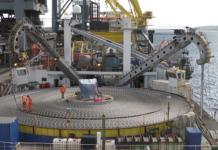 EA Technology’s Jason Butler says mission critical sites should use partial discharge monitoring to avoid unplanned outages. In the worst case scenario, failures have resulted in explosive consequences. Louise Frampton reports
EA Technology’s Jason Butler says mission critical sites should use partial discharge monitoring to avoid unplanned outages. In the worst case scenario, failures have resulted in explosive consequences. Louise Frampton reports
There are two main constituents to the HV grid: cables and switchgear. In both, their insulation slowly deteriorates over time until they are either replaced or they fail. This is also true for transformers and, to a lesser degree, overhead lines. EA Technology’s Jason Butler warns that substation failures can be devastating and mission critical sites must take action to prevent the causes of downtime.
He reports that a recent incident involving cable failure cost one business more than £6m in just one day due to lost production. It is not just the financial losses that businesses need to be concerned with, however; such failures can also lead to reportable health and safety incidents and, in extreme cases, result in serious injuries or fatalities.
“An 11kV failure can have the same explosive power as two kilos of plastic explosive,” comments Butler.
However, cables (especially underground cables) and switchgear, are difficult to test during routine maintenance and need to be isolated before a thorough inspection can be made. Nevertheless, there is a way of identifying those elements that are in danger of failing: partial discharge (PD).
This phenomenon refers to the minute ultrasonic and electrical emissions caused by breakdown of insulation. If left untreated, this leads to progressive deterioration and eventual failure. PD is the most common cause of disruptive failure of switchgear, and its detection and trending can help identify those parts of the network that require more urgent attention.
Using simple measuring techniques, it is possible to assess the rate at which assets are ageing, identify at-risk components and help justify future funding for replacement or maintenance.
“If you are not monitoring for PD, you are missing out on 80% of the indication of deterioration of your assets,” Butler warns. “Thermography is a useful approach to detecting issues and will highlight ‘hot spots’, but it is best suited to low voltage applications. PD provides a complementary approach as it is non-intrusive. You don’t need to go into the high-voltage enclosure and you can therefore avoid the associated dangers.”
There are various ways in which PD can be detected, including the measurement of electromagnetic radiation and detection of ultrasound.
Electromagnetic radiation
The electromagnetic radiation component of PD impinges on the metal cubicle of switchgear and induces a tiny but measurable voltage, called a transient earth voltage (TEV). TEV detection is a very effective way of establishing if there is any PD emanating from voids within solid insulation of HV components.
Ultrasound
The ultrasonic component of PD (akin to the crackle that can be heard if you walk under a pylon line on a misty morning) escapes the enclosures via the many air gaps. It can be analysed using a handheld device equipped with a tuned ultrasonic detector.
By utilising online, non-intrusive detection techniques, such as TEV and ultrasound, it is possible to scan HV switchgear quickly and pinpoint to a matter of inches where the PD is emanating from. The installation can then be isolated to allow an intrusive inspection to confirm the presence of PD.
The UltraTEV Plus handheld PD analyser is capable of measuring, interpreting and reporting on TEV, as well as ultrasonic activity.
For more critical infrastructure, however, a permanent monitoring solution, such as the UltraTEV Monitor, may be preferable. This measures PD continuously, with in-built trend analysis and alarms that can be linked to a SCADA system, a desktop computer or mobile phone.
“This technology is ideal for assets that would keep you awake at night if they failed; on a hospital site, for example, the monitoring system would be connected to the substation that powers the high-dependency unit, baby unit, or theatres,” Butler comments.
He reveals that the technology has already been installed for critical banking applications at Canary Wharf, for a number of data centres, and even a chocolate factory.
“They dread losing power because the chocolate solidifies in the pipes,” Butler explains. “Steel works also face a similar issue with molten steel solidifying in machinery, in the event of a power outage.”
Ultimately, critical high voltage assets can fail at any time depending on how well they have been planned, installed and maintained. Prevention is always better than cure and generally more effective.
Monitoring of HV assets allows trends in activity to be seen. Different sites can then be compared for HV reliability – a critical index for future plant investment plans.
“PD detection doesn’t replace the engineer,” Butler concludes. “But it does provide better data to make better, informed decisions, saving time, money and reducing risk.”



